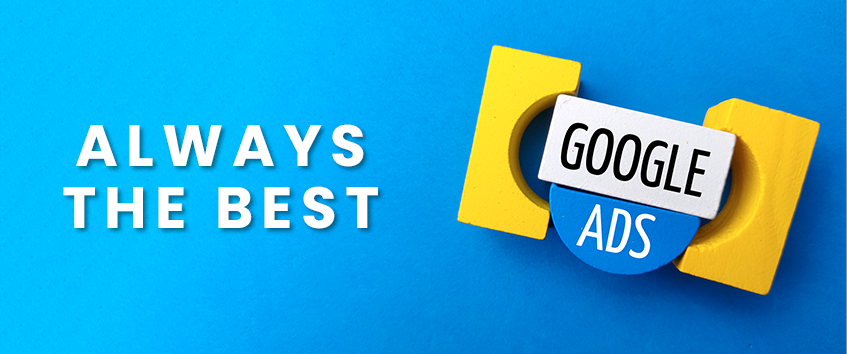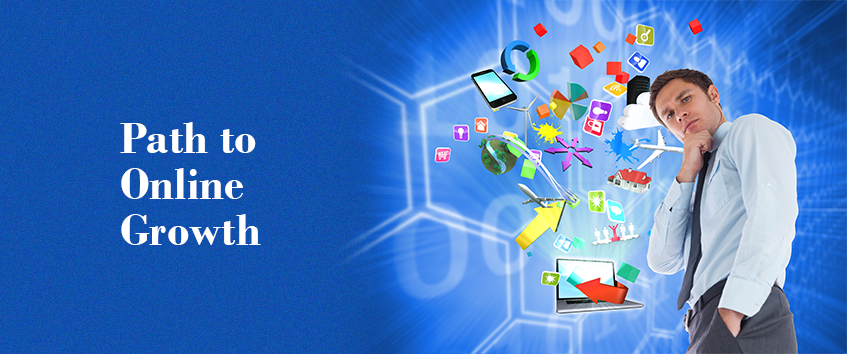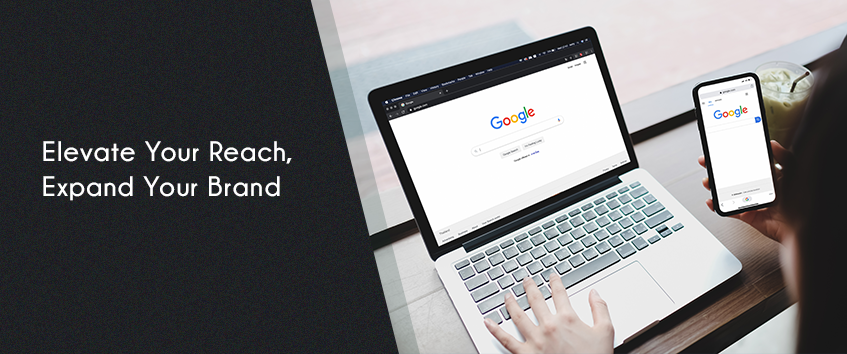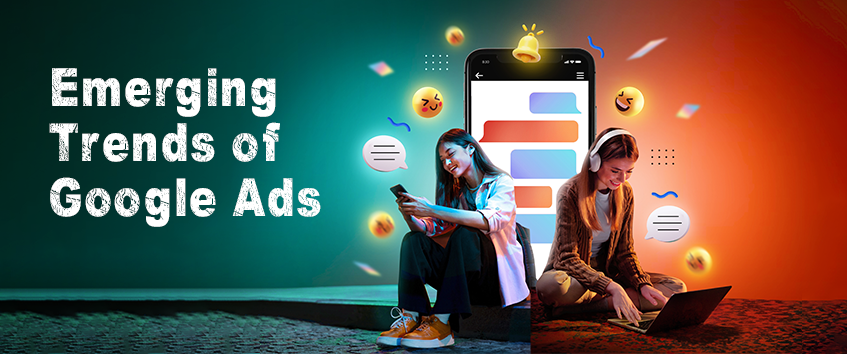Google Ads, Emerging Trends & Scope
August 31, 2023
In today’s digitally driven world, advertising has grown into a dynamic and expert landscape, with Google Ads leading the push. For more than two decades, Google Ads has been a dominant force in online advertising, but as technology and consumer behavior continue to advance, it is critical to keep an eye on future trends and predictions. As businesses continue to adapt to changing consumer behaviors and technology breakthroughs, the future of Google Ads promises to be an exciting journey full of innovation, challenges, and limitless opportunity. In this blog article, we are looking at the new trends and predictions affecting the future of Google Ads.
What exactly are Google Ads?
Google Ads is the brand name for Google’s pay-per-click (PPC) program, which allows businesses to obtain visibility across all of Google’s domains. Google Ads, formerly known as Google AdWords, has an interesting history that tracks the rise and evolution of the digital advertising industry. The birth of this first self-serve online advertising platform, Google AdWords was on October 23, 2000, so that date will always be remembered by the online world.

The most frequent sort of Google advertisement ad is a search ad, which displays on the Search Engine Results Page (SERP) for queries related to the advertiser’s products and services—however, businesses are widely using this way for marketing.
Here are some of the primary types of Google Ads:
Search Ads:These are text-based ads that appear at the top or bottom of Google search results when users enter relevant search queries. They are triggered by specific keywords and can include ad extensions like site links, callouts, and call extensions. There are paid and general search ads.
Display Ads: Display ads are visual ads that appear on websites within Google’s Display Network, which includes a vast network of partner websites, blogs, and apps. These ads can be in the form of banners, images, interactive ads, or even video ads.
Video Ads: Video ads are displayed on YouTube and across the Google Display Network. They can play before, during, or after YouTube videos, or even as display ads on other websites. Video ads can be skippable or non-skippable and are a powerful way to engage audiences with audiovisual content.
Shopping Ads: Formerly known as Product Listing Ads (PLAs), shopping ads are designed for e-commerce businesses. These ads display product images, names, prices, and the retailer’s name directly in Google search results. They are highly visual and help users discover products and make purchasing decisions.
App Promotion Ads: These ads are designed to promote mobile apps. They can appear on the Google Search Network, Google Display Network, YouTube, and within other apps. App promotion ads encourage users to download or engage with mobile applications.
App Campaigns: App campaigns streamline the process of advertising across multiple Google platforms for app promotion. Advertisers provide assets like text, images, and budget, and Google’s machine learning technology automatically optimizes the ads placement and targeting to achieve the campaign’s goals.

What are the benefits of using Google Ads?
1. It will increases leads and customers
Google Ads is one of the most successful ways for lead generation. If your campaigns are properly configured, they have the potential to bring highly targeted leads to your website. Google Ads lets you target people who are looking for what your company has to offer. This means you may constantly adjust your searches so that only people interested in purchasing your products or services are directed to your websites via this platform.
2. It is a versatile marketing platform
Anyone who regularly utilizes Google Ads will tell you that it is an exceptionally versatile marketing tool. It is appropriate for organizations of all shapes and sizes. Using this technique, you can effectively turn on and off internet traffic. It also works with a variety of different marketing platforms and software solutions. You may quickly tailor campaigns to target specific sorts of internet users. As a result, it is far more adaptable.
3. Gain a high ROI
Unlike other marketing tactics, Google Ads requires you to pay only for advertisements that are clicked on. You can receive a high ROI(return on investment) by optimizing Google Ads campaigns, which may not be attainable with other marketing tactics. When you identify areas of your campaign that provide a good return on investment, you should concentrate your efforts and resources there.
4. Allows for Ad Extensions
Google Ads offers various options to include ad extensions, such as call extensions, site link extensions, and location extensions. These extensions provide additional information to users and increase the visibility of your ads.
5. Competitive Analysis
Through Google Ads, you can gain insights into your competitor’s ad strategies, keywords, and ad placements. This information can be valuable in refining your own campaigns.
Overall, Google Ads provides businesses with highly focused, measurable, and cost-effective solutions to engage their target audience, raise brand awareness, and drive transactions. To achieve the best results, however, well-crafted campaigns, continuous optimizations, and performance monitoring are required.
1. AI-Powered Personalization: Revolutionizing Ad Targeting
As Artificial intelligence (AI) continues to mature, its integration into Google Ads is becoming increasingly profound. AI algorithms can analyze vast amounts of data in real time, enabling advertisers to understand their audience better than ever before. In the future, AI-powered personalization will become a cornerstone of Google Ads campaigns. Advertisers will be able to create hyper-targeted ads that resonate with individual consumers on a personal level, boosting engagement and conversion rates. From ad copy to visuals, AI will drive unparalleled personalization, making ads feel like tailored recommendations rather than generic promotions.
2. Voice Search and Visual Discovery: Shaping Ad Formats
The rise of voice-activated devices and visual search technologies is poised to reshape the way we interact with Google Ads. Voice search is becoming increasingly popular, demanding a new approach to keyword targeting and ad optimization. Advertisers will need to adapt their content to match the conversational nature of voice queries, focusing on providing concise yet informative responses.
Moreover, visual discovery is gaining traction, allowing users to search using images rather than text. As this technology advances, image-based ads will gain prominence, requiring advertisers to craft visually compelling content that can communicate messages effectively without relying solely on text.
3. Augmented Reality (AR) and Interactive Ads: Immersive Experiences
As AR technology becomes more accessible and sophisticated, interactive ads will gain traction in the Google Ads ecosystem. Augmented reality allows users to engage with products and experiences in real time, transcending the limitations of traditional static ads. Imagine trying on virtual makeup before purchasing, or visualizing furniture in your living room through your smartphone screen. These interactive experiences will not only captivate audiences but also empower them to make more informed purchasing decisions.
4. Privacy and Data Ethics: Navigating a New Advertising Landscape
With various privacy regulations and growing consumer concerns about data security, the future of Google Ads will be shaped by a strong emphasis on user privacy and data ethics. Google has already made moves to phase out third-party cookies, which have been a staple for ad targeting. In this evolving landscape, advertisers will need to adopt innovative techniques such as federated learning and differential privacy to gather insights without compromising user data. Building trust through transparent data usage and meaningful consent mechanisms will be critical for advertisers looking to thrive in this new era of privacy-focused advertising.
5. Video Dominance and Shoppable Content: The YouTube Connection
Video content is already a dominant force in digital advertising, and this trend is set to continue in the future. YouTube, being a part of the Google ecosystem, will play a pivotal role in shaping the future of Google Ads. Video ads will become more engaging and seamlessly shoppable, allowing viewers to make purchases directly from videos. This fusion of entertainment and commerce will redefine the shopping experience, transforming passive viewers into active consumers.
Predicting the Future: A Balance of Innovation and Adaptation
Predicting the exact future of Google Ads is as complex as the digital landscape itself. However, one thing is clear, that the future will be shaped by a delicate balance between innovation and adaptation. Advertisers who embrace AI-powered personalization, navigate the challenges of privacy and data ethics, leverage interactive technologies, and harness the potential of video advertising will position themselves at the forefront of this ever-evolving industry.

Although Google Ads continues to be the primary player in online advertising, other platforms such as Amazon, Facebook, and TikTok are growing their competitiveness. Expect more difference and innovation from these competitors as they compete for a larger portion of the advertising industry.
In conclusion, the future of Google Ads is an exciting amalgamation of cutting-edge technologies, user-centric strategies, and ethical considerations. As advertisers, marketers, and businesses, the key lies in staying attuned to emerging trends, being open to experimentation, and embracing change with a forward-looking mindset. The journey ahead promises to be both challenging and rewarding, as we collectively shape the future of digital advertising through Google Ads.Overall, as the platform adjusts to new technology and customer behavior, the future of Google Ads is likely to be marked by continuing innovation and evolution. Advertisers who stay on top of these trends and incorporate them into their plans will be the most successful in the coming years.
Want a quick sale? Now is the time to use Google Ads.
That being said, Monolith, the best digital marketing agency, is here to help you out by telling you how Google Ads works and how you should get started.
So why not create your free Google Ads account ASAP?

